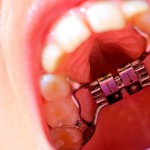
Between 8-10% of people have are considered to have a transverse maxillary deficiency which manifests clinically as a unilateral or bi-lateral crossbite, narrow nasal cavity, arch length discrepancy, and crowding. Rapid maxillary expansion using either tooth-borne, bone-borne or hybrid tooth-bone-borne appliances have been used as treatment approaches.
The aim of this review was to compare the clinical effects of bone-borne or hybrid tooth-bone-borne rapid maxillary expansion (RME) with conventional tooth-borne RME in the treatment of maxillary deficiency.
Methods
Searches were conducted in the Medline/PubMed, Embase, Cochrane Library, Virtual Health Library (including Bibliography Brazilian Dentistry and LILACS), Scopus, ISI Web of Knowledge, ClinicalTrials.gov, the data- bases Directory of Open Access Journals (DOAJ), Digital Dissertations (via UMI Proquest), metaRegister of Controlled Trials, WHO trials search portal, and Google Scholar. Randomised controlled trials (RCTs) in patients with transverse maxillary deficiency treated with bone-borne compared to tooth-borne with maxillary expansion as the primary outcome were considered.
Studies were screened and selected by one reviewer who also extracted data and assessed risk of bias using the Cochrane tool. The process was independently verified by a second reviewer.Random effects meta-analyses of mean differences (MD) and their 95% confidence intervals (CIs) were undertaken. The overall quality of the evidence was assessed using the Grades of Recommendation, Assessment, Development, and Evaluation (GRADE) approach.
Results
- 6 RCTs (264 patients) reported in 12 publications were included.
- The experimental arms of 2 trials involved a pure bone-borne RME, 3 trials a hybrid tooth-bone-borne appliance and one trial included both all 6 compared with a conventional tooth-borne RME appliance as a control.
- One trial was considered to be at low risk of bias, 2 at unclear risk and 3 at high risk.
- Bone-borne RME compared to tooth-borne RME
- 1 RCT indicated there was greater suture opening at the first molar post-retention; MD = 2.0 mm (95%CI; 1.4 to 2.6 mm).
- No significant differences could be found regarding tooth inclination, nasal cavity width, and root resorption (very low to low evidence quality).
- Hybrid tooth-bone-borne RME compared to tooth-borne RME
- was associated with less buccal tipping of the first premolar MD = - 4.0° (95%CI; - 0.9 to - 7.1°) (2 trials moderate evidence quality) and
- lower nasal airway resistance post-retention MD = - 0.2 Pa s/cm3 (95%CI; - 0.4 to 0 Pa s/cm3) (1 trial; moderate evidence quality).
- No significant difference could be found regarding skeletal maxillary width, molar inclination, and analgesic use (low to moderate evidence quality).
Conclusions
The authors concluded: –
Limited evidence from randomized trials indicates that bone-borne or hybrid tooth-bone-borne RME might present advantages in terms of increased sutural opening, reduced tooth tipping, and lower nasal airway resistance compared to conventional tooth-borne RME. However, the limited number of existing studies and issues in their conduct or reporting preclude the drawing of definite conclusions.
Comments
While this review has been well conducted including a very broad search of the literature only a limited number of small studies were identified. In addition, only one of the included studies was considered to be at low risk of bias. So, while the available studies suggest a potential advantage from RME that are partially or completely anchored skeletally the limited quality of the studies means the findings should be viewed cautiously. Well conducted and reported studies of appropriate size are needed that used a common outcome set that also includes patient relevant outcomes and adverse effects.
Links
Primary Paper
Krüsi M, Eliades T, Papageorgiou SN. Are there benefits from using bone-borne maxillary expansion instead of tooth-borne maxillary expansion? A systematic review with meta-analysis. Prog Orthod. 2019 Feb 25;20(1):9. doi:10.1186/s40510-019-0261-5. Review. PubMed PMID: 30799516; PubMed Central PMCID:PMC6387979
Other references
Dental Elf – Rapid Maxillary Expansion blogs
